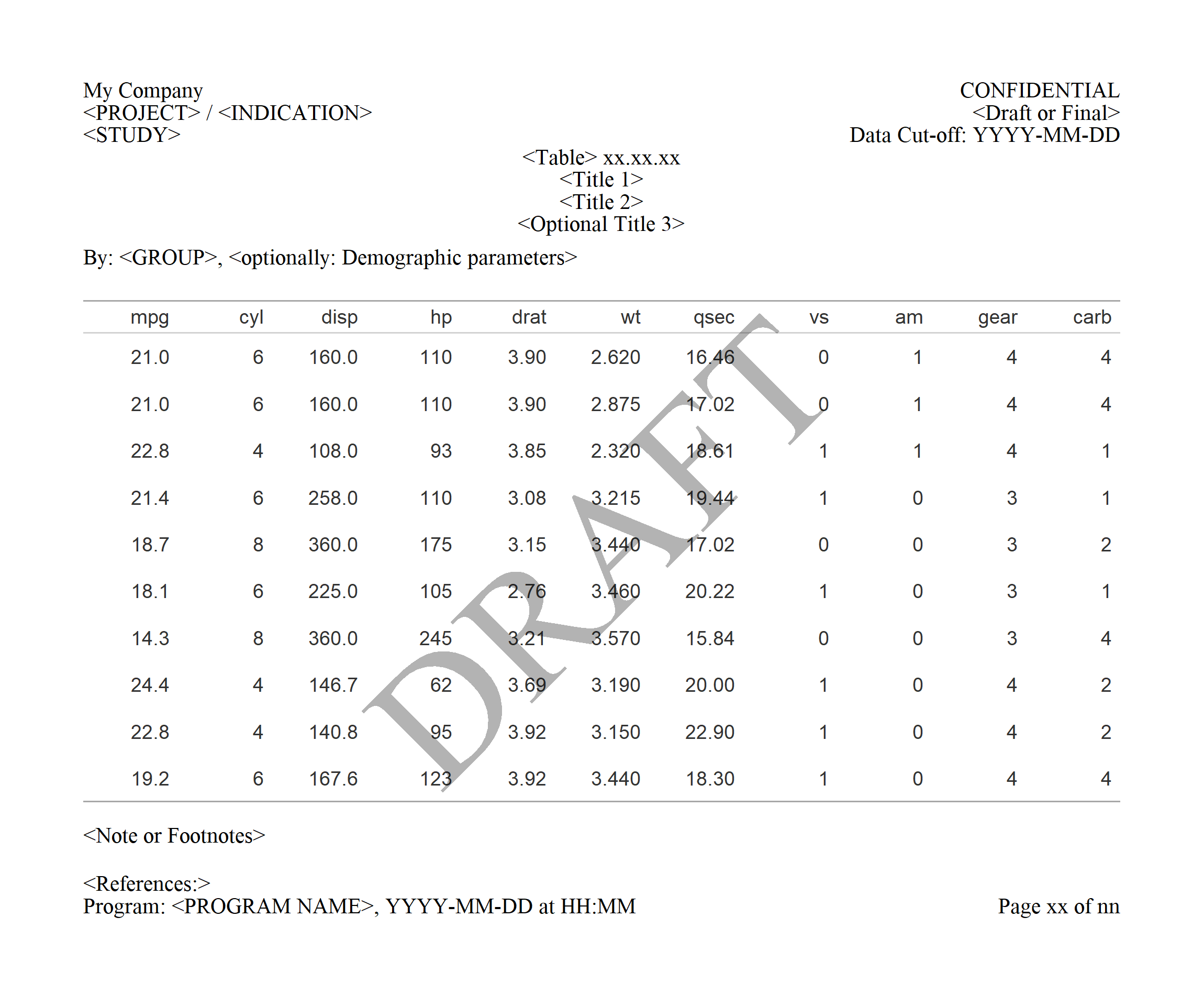
The hardware and bandwidth for this mirror is donated by dogado GmbH, the Webhosting and Full Service-Cloud Provider. Check out our Wordpress Tutorial.
If you wish to report a bug, or if you are interested in having us mirror your free-software or open-source project, please feel free to contact us at mirror[@]dogado.de.

In the pharmaceutical industry, and many other fields that rely heavily on data reporting, there is often a need to create figures and tables with specific graphical arrangements. These could be titles, subtitles, captions, footnotes, and other text elements that provide important context to the data being shown.
However, creating the headers and footers etc. and correctly positioning them around the output can be challenging, often requiring fine-tuning. This can be time-consuming and can lead to inconsistencies in the way the figures and tables are presented across different projects.
gridify builds on the base R grid package
and makes it easy to add flexible and customizable information around a
figure or table using a pre-defined or custom layout. The
gridify package works with all of the following input
types, creating consistency when using various different inputs:
grob, gtable,
ggplot, flextable,
gt, base R plots (by formula)
Whilst rtables are not directly supported, we can use
rtables with gridify by first converting
them to flextable.
As gridify is based on the graphical tool
grid, any figure or table inputs are converted to a
grob object in gridify and the result of using
gridify is always a graphical image.
You can install the newest release version from CRAN:
install.packages("gridify")Or you can install the newest development version from Pharmaverse GitHub (example):
# install.packages("remotes")
remotes::install_github("pharmaverse/gridify", build_manual = TRUE)The workflow of the package is as follows:
ggplot, gt etc.)get_layouts() to see the predefined optionsgridify() to create a gridify
objectgridify object to see empty cellsset_cell() to fill in the various text elements in
the layout (headers, footers etc.)The following example uses a table created by the gt
package and the gridify layout
pharma_layout_base().
library(gridify)
# install.packages("gt")
# gt needs gtable
# install.packages("gtable")
library(gt)
# (to use |> version 4.1.0 of R is required, for lower versions we recommend %>% from magrittr)
tab <- gt::gt(head(mtcars, n = 10)) |>
gt::tab_options(
table.width = gt::pct(100),
data_row.padding = gt::px(10),
table_body.hlines.color = "white",
table.font.size = 12
)
# Use `gridify()` to create a `gridify` object
gridify_object <- gridify(
object = tab,
# Choose a layout (predefined or custom)
layout = pharma_layout_base(
margin = grid::unit(c(0.5, 0.5, 0.5, 0.5), "inches"),
global_gpar = grid::gpar(fontfamily = "serif", fontsize = 10)
)
)
# Print the `gridify` object to see empty cells
gridify_object
# Use `set_cell()` to fill in the various text elements in the layout (headers etc.)
gridify_object_fill <- gridify_object |>
set_cell("header_left_1", "My Company") |>
set_cell("header_left_2", "<PROJECT> / <INDICATION>") |>
set_cell("header_left_3", "<STUDY>") |>
set_cell("header_right_1", "CONFIDENTIAL") |>
set_cell("header_right_2", "<Draft or Final>") |>
set_cell("header_right_3", "Data Cut-off: YYYY-MM-DD") |>
set_cell("output_num", "<Table> xx.xx.xx") |>
set_cell("title_1", "<Title 1>") |>
set_cell("title_2", "<Title 2>") |>
set_cell("title_3", "<Optional Title 3>") |>
set_cell("by_line", "By: <GROUP>, <optionally: Demographic parameters>") |>
set_cell("note", "<Note or Footnotes>") |>
set_cell("references", "<References:>") |>
set_cell("footer_left", "Program: <PROGRAM NAME>, YYYY-MM-DD at HH:MM") |>
set_cell("footer_right", "Page xx of nn") |>
set_cell("watermark", "DRAFT")
gridify_object_fill
print(gridify_object_fill)
Note: Get the image using
export_to(gridify_object_fill, to = "mypng.png", res = 300, width = 2300, height = 1900)
For more information please visit the following vignettes:
vignette("gridify", package = "gridify") - A case study in
how the above example is constructed.vignette("simple_examples", package = "gridify") - A
showcase of implementations of gridify for the various
possible inputs.vignette("multi_page_examples", package = "gridify") -
Showing how to use gridify in more complex situations e.g a
for-loop for multiple results.vignette("create_custom_layout", package = "gridify") - An
explanation on how to create a custom layout to use in
gridify.vignette("transparency", package = "gridify") - How to
extract the raw grid code to reproduce a gridify
object.Other packages exist which add headers, footers, and other elements
to figures and tables; most of the input classes to gridify
already support these features. However, gridify was
created not to supersede these, but to be used in conjunction with, in a
way that is flexible for all use cases and consistent across various
inputs.
Interested in contributing? Check out the contributing guidelines,
CONTRIBUTING.md. Please note that this project is released
with a Code of Conduct, CODE_OF_CONDUCT.md. By contributing
to this project, you agree to abide by its terms.
Along with the authors and contributors, thanks to the following people for their support:
Alberto Montironi, Jonathan Bleier, Cynthia McShea, Nils Penard, Oswald Dallimore, Laetitia Lemoine, Daniel Vicencio Perez, Richard Abdy
These binaries (installable software) and packages are in development.
They may not be fully stable and should be used with caution. We make no claims about them.
Health stats visible at Monitor.